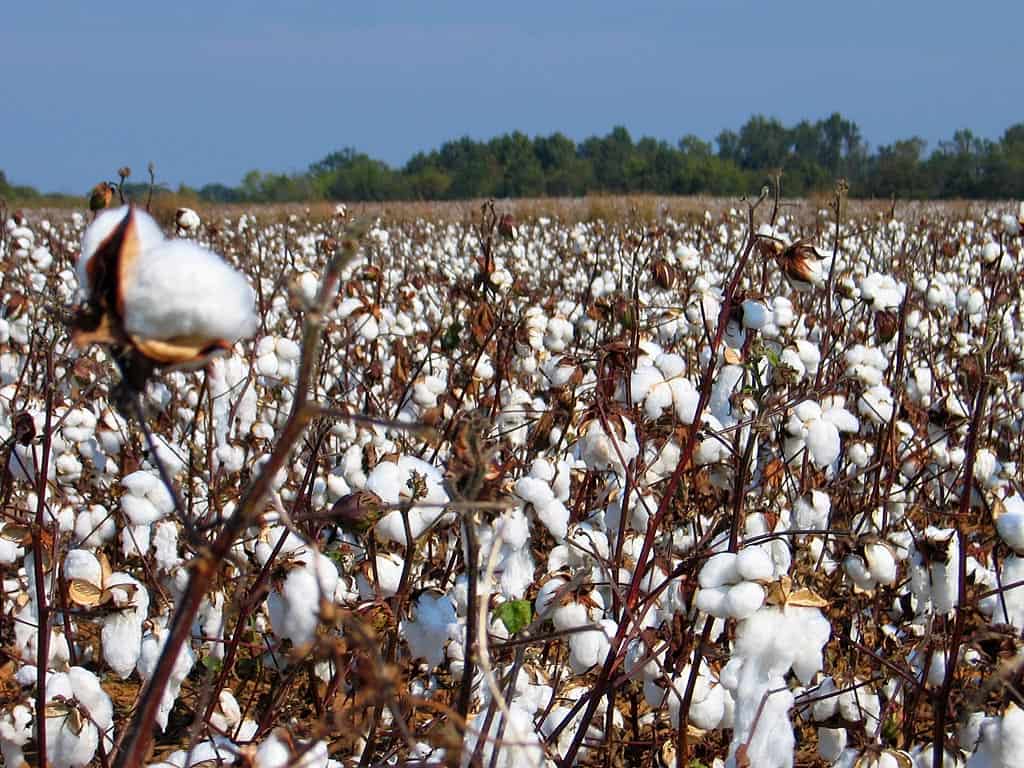Cotton or Snow?

Visitors of all ages are fascinated with the snowy white cotton bolls growing along the sides of the road in northeastern NC. A field of white cotton creates the illusion of snow fall in 90 degree temperatures! Many have shared personal stories of picking cotton or spinning the fibers into thread. Local farmers graciously allow the Dismal Swamp Canal Welcome Center to cut several stalks annually to use as educational and decorative tools.
North Carolina is ranked eighth nationally in the production of cotton, with Texas and Georgia leading the way. It is one of the oldest fibers under human cultivation, with traces of cotton over 7,000 years old recovered from archaeological sites in Mexico and Egypt.
A member of the mallow plant family, cotton produces delicate lovely flowers. Each spring the seeds are mechanically planted in state approved areas with suitable fertile soil and climate. Regulation is required to protect against boll weevil infestation. In late summer, the mature plant produces a bloom that changes from creamy white to dark pink and rarely last longer than a few days. From this flower, a rose-bud shaped pod or boll forms and the fiber and seeds develop inside. As the boll ripens, it turns brown. The fibers continue to expand and finally split the boll apart, exposing white fluffy cotton. The crop grows to a height of three to four feet and harvesting begins in early October to mid-December.
 The process of picking cotton was extremely laborious until the invention of the cotton gin, by Eli Whitney in 1793. The small, sharp teeth of the gin separate the seeds from the fiber and comb them for spinning. The ginned fiber or lint is pressed together and made into dense bales weighing approximately 500 pounds. Cotton bales are classified according to quality and sold.
The process of picking cotton was extremely laborious until the invention of the cotton gin, by Eli Whitney in 1793. The small, sharp teeth of the gin separate the seeds from the fiber and comb them for spinning. The ginned fiber or lint is pressed together and made into dense bales weighing approximately 500 pounds. Cotton bales are classified according to quality and sold.
While a single cotton fiber is not very strong, when multiple curling fibers are straightened and twisted together, they form a strong, smooth thread that can be knitted or woven, as well as dyed. Cloth for apparel, household and industrial uses is manufactured from high grade cotton. Many types are blended with other natural fibers, such as linen, to add texture and strength to the fiber.
Cotton is a part of our daily lives from the towels we use to the sheets we sleep on at night. It has hundreds of uses from clothing to shoe strings. All parts of the cotton plant are useful. The fiber is used in making cotton cloth. Linters, the short fuzz on the seed, provide cellulose for making plastics and high quality paper products. Seeds are crushed to produce three separate products- oil, meal and hulls. Cottonseed oil is used for shortening, cooking oil and salad dressing. The meal and hulls are used as livestock, poultry and fish feed and fertilizer. The stalks and leaves of the cotton plant are plowed under to enrich the soil.
 Cotton is subject to infestation, especially by the boll weevil, a little gray beetle with a long snout. The weevil feeds on newly developed bolls, destroying its growth. Many farmers heavily douse the plant in pesticides that are harmful to human and animal health, to help eliminate the boll weevil. The plant is also sprayed with a defoliant that causes its leaves to fall off.
Cotton is subject to infestation, especially by the boll weevil, a little gray beetle with a long snout. The weevil feeds on newly developed bolls, destroying its growth. Many farmers heavily douse the plant in pesticides that are harmful to human and animal health, to help eliminate the boll weevil. The plant is also sprayed with a defoliant that causes its leaves to fall off.
Careful cultivation, the right amount of rainfall, pest control and chemical defoliation are necessary to produce a bountiful harvest!
Resources & Images:
https://www.cotton.org/pubs/cottoncounts/story/
